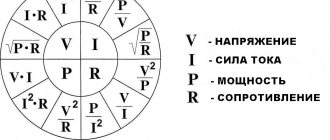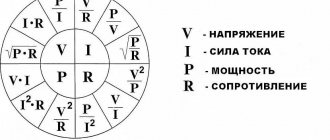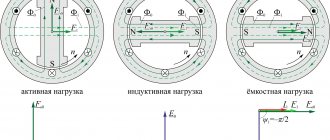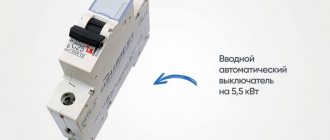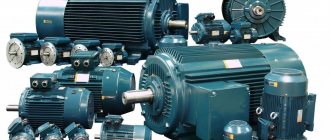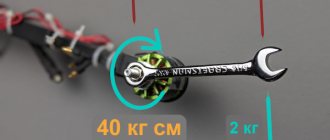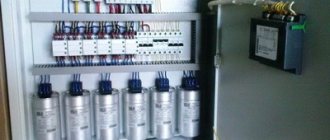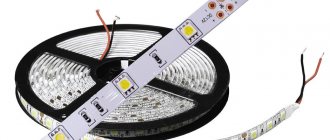Electrical power (DC)
What is electrical power? This is a quantity that shows us the speed of transmission or conversion of electricity into other forms. In simple words, power is the amount of work done over a certain period.
And here is the formula that shows us the above definition:
Power formula
P - power, A - current, t-time
I will give one more example to consolidate and understand such a definition as electrical power:
Let's imagine two people in the same weight category in different parts of the planet. Their cars of the same model and brand have run out of gas and they are pushing them to a gas station. The gas station is 100 meters in a straight line. The first drove his car in 10 minutes, and the second in 5. Accordingly, the second driver has more power.
Properties and technical characteristics of resistors
As already noted, resistors in electrical circuits and circuits perform a regulatory function. For this purpose, Ohm's law is used, expressed by the formula: I = U/R. Thus, with a decrease in resistance, a noticeable increase in current occurs. And, conversely, the higher the resistance, the lower the current. Due to this property, resistors are widely used in electrical engineering. On this basis, current dividers are created that are used in the designs of electrical devices.
In addition to the current regulation function, resistors are used in voltage divider circuits. In this case, Ohm's law will look slightly different: U = I x R. This means that as the resistance increases, the voltage increases. The entire operation of devices designed to divide voltage is based on this principle. For current dividers, resistors are connected in parallel, and for voltage dividers, resistors are connected in series.
In the diagrams, resistors are displayed in the form of a rectangle measuring 10x4 mm. The symbol R is used for designation, which can be supplemented with the power value of a given element. For power above 2 W, the designation is made using Roman numerals. The corresponding inscription is placed on the diagram near the resistor icon. Power is also included in the markings on the element body. The units of resistance are ohm (1 ohm), kilohm (1000 ohm) and megaohm (1,000,000 ohm). The range of resistors ranges from fractions of an ohm to several hundred megaohms. Modern technologies make it possible to produce these elements with fairly accurate resistance values.
How to find electrical power
The basic unit of electrical power is the Watt. Electrical power can be found using the following formula:
Power formula
Let's look at the formula I gave above.
I (current) - the amount of electricity flowing at a certain point in time;
U (voltage) is the work done by the electric field to transfer charge from point A to point B.
And now in simple words: Two people (this will be our current) carry together one stone from point A to point B weighing 50 kg and spend energy on it (this is voltage), and one person carries a stone weighing 10 kg and also spends energy . People have the same weight category. If we transfer this data into our formula, we find out that two people have more power than one.
Let me give you some more formulas that can be used to calculate electrical power:
Power formula
Where: I - current, U - voltage, R - resistance
As you can see, there is nothing complicated, because we are considering direct current.
Installed capacity is. What is Installed Capacity?
- production equipment;
- workplaces (including workbenches, assembly stands, etc.);
- reserves (blanks, parts, assemblies) at workplaces;
- passages between equipment and between workplaces (except for main passages).
Example 1
There are 2 laser complexes on the site. In July next year it is planned to purchase another one, similar to the existing ones.
The site produces kits of parts. The production (cutting) of one set takes 30 minutes of operation of the laser complex. Thus, at the beginning of the period, in 1 hour, the site produces 4 sets of parts, at the end of the period - 6 sets.
Let us assume that the actual (working) operating time of the equipment is 7300 hours. Let us determine:
During the planned economy, production capacity was calculated in accordance with methodological provisions common to enterprises in all industries, specified in industry methodologies. Some enterprises still use these techniques.
Let us adapt the main methodological provisions of these documents to the market situation:
• The production capacity of the enterprise is determined by the capacity of the leading divisions (shops, sections, units), taking into account the existing cooperation and measures to eliminate bottlenecks.
The leading division is considered to be the one in which the main technological operations for the manufacture of products are performed, the largest share of equipment working time is spent, and a significant part of the fixed production assets of this enterprise is concentrated.
Capacity calculations are carried out for all production divisions of the enterprise sequentially from the lowest production level to the highest: from groups of technologically similar equipment to production areas, from areas to workshops, from workshops to the enterprise as a whole.
A “bottleneck” is understood as a discrepancy between the capacities of individual workshops, sections, groups of equipment and the capacities of the corresponding divisions, by which the capacity of the entire enterprise or workshop is determined.
• The production capacity of the enterprise is dynamic; it changes due to increased labor productivity, improved organization of production, and improved qualifications of workers.
An increase in production volume due to measures to improve production efficiency aimed at developing planned production capacity is not considered an increase in production capacity.
When determining production capacity, the following factors are taken into account (see figure).
To calculate production capacity, the following data is used:
Power calculations are carried out for all production equipment assigned to workshops.
Production equipment includes equipment with the help of which the technological process of manufacturing commercial products is directly carried out at the enterprise.
The calculation takes into account operating equipment and inactive equipment due to malfunction, repair, modernization, lack of loading and other reasons.
Determining the estimated power from the installed power and the demand factor is an approximate method, in particular because Kc changes with the number of homogeneous receivers in one node, and in reference books it is given as a constant value and is recommended only as a preliminary one.
Example 1. Determine the design load of a group of receivers in the DSK concrete mixing shop. The source data (in bold) and the calculation results are summarized in the table below.
Initial data and calculation results
| Receiver group | Number of receivers n, pcs. | Total installed capacity, Ru kW | Demand coefficient Ks | COSφ | tg φ | Design loads | ||
| active Рр, kW | reactive Qp, kvar | full S, kV A | ||||||
| Conveyor | 16 | 191,4 | 0,8 | 0,75 | 0,882 | 153,1 | 135 | — |
| Vibrator | 23 | 158,5 | 0,6 | 0,75 | 0,882 | 95 | 83,8 | — |
| Fan, pump | 8 | 18 | 0,8 | 0,85 | 0,62 | 14,4 | 8,9 | — |
| Dispenser | 2 | 9 | 0,35 | 0,5 | 1,732 | 3,2 | 5,4 | — |
| Total | 49 | 376,9 | 0,6 | 0,697 | 1,03 | 225,7 | 232,2 | 324,2 |
| Receiver group | Number of receivers n, pcs. | Total installed capacity, Ru kW | Demand coefficient Ks | COSφ | tg φ | Design loads | ||
| active Рр, kW | reactive Qp, kvar | full S, kV A | ||||||
| Conveyor | 16 | 191,4 | 0,8 | 0,75 | 0,882 | 153,1 | 135 | — |
| Vibrator | 23 | 158,5 | 0,6 | 0,75 | 0,882 | 95 | 83,8 | — |
| Fan, pump | 8 | 18 | 0,8 | 0,85 | 0,62 | 14,4 | 8,9 | — |
| Dispenser | 2 | 9 | 0,35 | 0,5 | 1,732 | 3,2 | 5,4 | — |
| Total | 49 | 376,9 | 0,6 | 0,697 | 1,03 | 225,7 | 232,2 | 324,2 |
Expert opinion
It-Technology, Electrical power and electronics specialist
Ask questions to the “Specialist for modernization of energy generation systems”
Design power - Great Encyclopedia of Oil and Gas, article, page 1 Design power is conditional and does not coincide with the actual power that the transformer delivers during operation. Ask, I'm in touch!
Electrical power in an alternating current circuit
In an alternating current circuit there is useful power, useless power and their sum. In electricity, these electrical powers are called as follows: apparent power, active power, reactive power.
I suggest you watch the following video, which explains the essence of the components of power:
We calculate the components of total power:
power triangle
Does everyone know the Pythagorean theorem? In a right triangle, the square of the hypotenuse is equal to the sum of the squares of the legs:
Pythagorean theorem
Now let's apply this to our power triangle:
Total Power Formula
Increasing battery voltage
Let's try taking the same circuit and increasing the battery voltage to see what happens. Intuition tells us that as the voltage increases, the current in the circuit will increase, but the resistance of the lamp will remain the same. In the same way, the power will increase:
Figure 2 – Example of an electrical circuit
The battery voltage is now 36 volts instead of 18 volts. The lamp still provides 3 ohms of electrical resistance for the current to pass. Now the current is:
\
This is clear: if I = E/R, and we double E and R remains the same, the current must also double. That's right: now we have a current of 12 amperes, instead of 6 A. What about power?
\
Calculate electrical power
Factories pay for full capacity, unlike ordinary consumers. Active power is found using the following formula:
Active power formula
Сosф is the angle on our power triangle (power factor, it cannot be more than one)
From this formula we will derive cosФ and get the following:
Cosine phi
We determine reactive power:
Reactive power formula
sinФ is the reactive power factor. The formula for determining sinФ is as follows:
sine phi
Characteristics of three-phase circuits
- To calculate the power rating of a three-phase machine, it is necessary to sum up the entire power of electrical appliances that will be connected through it. ...
- L1 5000 W + L2 5000 kW + L3 5000W = 15000 W.
- We convert the resulting watts into kilowatts:
- 15000 W / 1000 = 15 kW.
- We multiply the resulting number by 1.52 and get the operating current A.
Useful tips Connection diagrams Principles of operation of devices Main concepts Meters from Energomer Precautions Incandescent lamps Video instructions for the master Testing with a multimeter
Let's sum it up
- What is reactive (useless) power - a situation when the current lags behind or leads the voltage, i.e. when the voltage has reached its peak and the current is zero and vice versa;
- Where does reactive power come from - mainly due to electric motors and transformers (this point is not clear to you yet, if you are a beginner, subscribe to the blog and wait for an article about the inductor);
- Is reactive power useful - it is useless and does not produce any useful work, it only heats the wires, therefore, in order to reduce the cross-section of the cable, we need to compensate for the reactive component. Also, factories pay for full power, so they need to compensate for the reactive component;
- How reactive power is compensated - installations are connected to the network to compensate reactive power;
- What causes the reactive component - primarily electric motors, transformers;
OK it's all over Now! Subscribe and stay tuned for blog updates!
Find out the power consumption of electricity
According to the formula, we need to add everything and divide by 1000 to convert from watts to kilowatts.
In total, we got 10975 watts, let's convert it to kilowatts, dividing by 1000.
What kind of lighting do you prefer?
Built-in Chandelier
For the average person, one phase is quite enough. Especially if you are not going to turn everything on at the same time, which is, of course, unlikely.
But you need to remember that current consumption can be significantly higher, especially if you live in a private house and/or have a garage, then the consumption of one device can be 4-5 kW. Then you will prefer a three-phase network, as it is more powerful and allows you to connect significantly more powerful current consumers.


